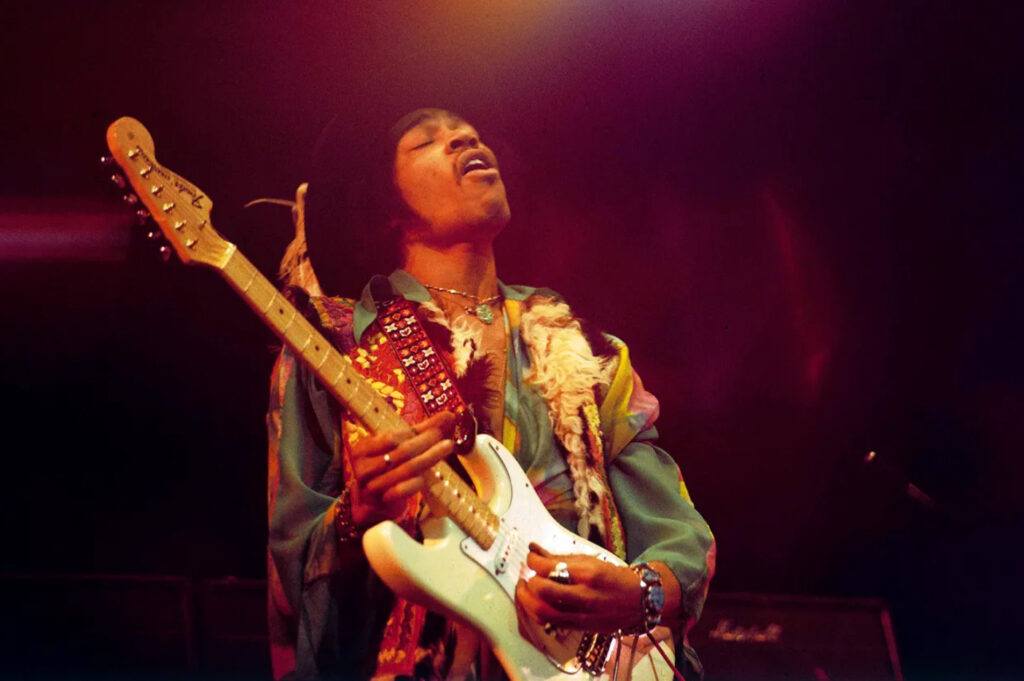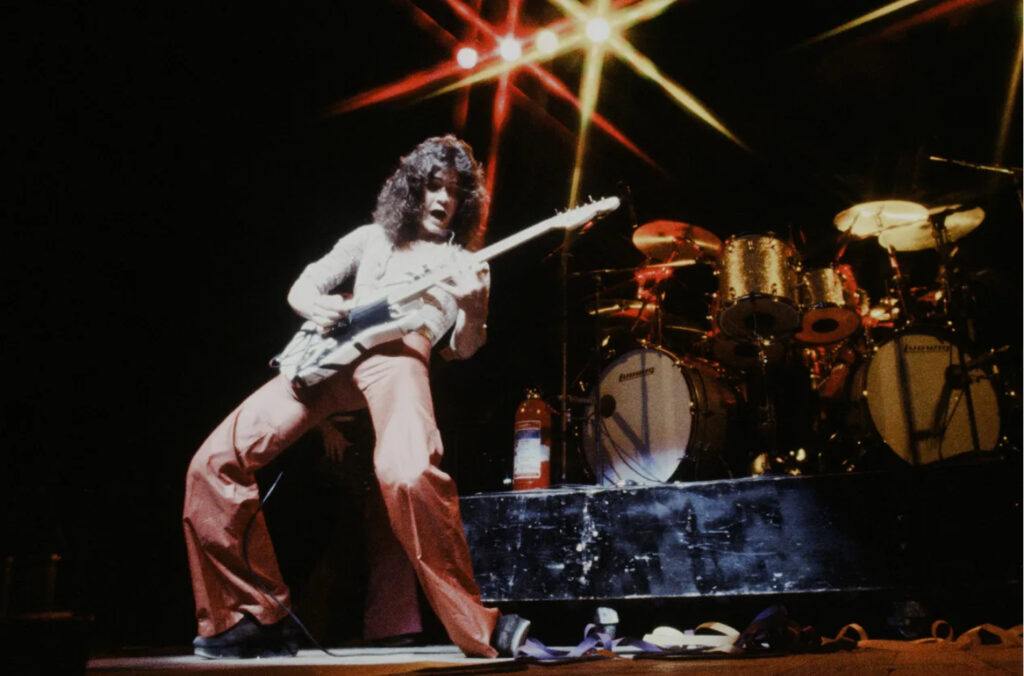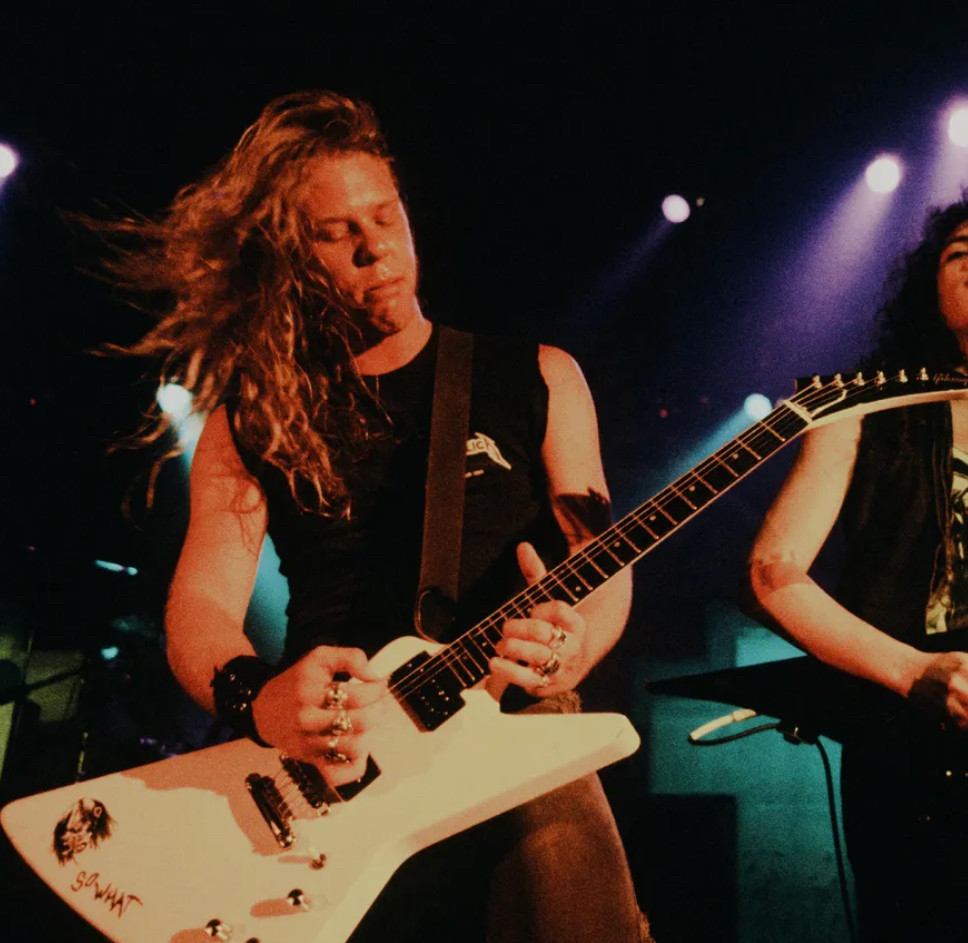I’m a self-taught lead guitarist, but I’ve noticed that the core of a song often relies heavily on rhythm playing.
Legendary guitarists like Jimmy Page, Stevie Ray Vaughan, Jimi Hendrix, and Eddie Van Halen have dazzled us with solos, but their rhythm playing was just as extraordinary.
When it comes to rhythm, it’s not just about the chords you play; it’s about HOW you play them. Each strum is a brushstroke that paints the song’s mood and groove.
Let’s take a look at strumming secrets and how iconic rock guitarists do it.

His dynamic playing could drive a song forward or lay down a complex, melodic backdrop for Led Zeppelin’s powerhouse sound. Page’s style is deeply rooted in blues, which he often blended with rock to create powerful riffs.
His use of blues scales and chord progressions added a raw and emotive quality to Led Zeppelin’s sound.

Another master of groove. His tight, provocative rhythms laid the groundwork for his blistering leads. Deeply rooted in Texas blues, Vaughan’s style drew from blues legends like Albert King and B.B. King.
His rhythm playing exuded authenticity and emotional depth. Vaughan often employed shuffle rhythms, adding a swinging feel to his playing. This technique was crucial in driving the energy of his music and capturing the essence of traditional blues.

The one-and-only, who changed the game by integrating lead-style embellishments into his rhythm parts, blurring the lines between the two roles. Hendrix was renowned for his use of extended chords, such as seventh and ninth chords, which added complexity and richness to his rhythm playing.
He often used thumb-over-neck techniques to allow more freedom with his chord voicings. He uniquely blended rhythm and lead by incorporating melodic lines within his chord progressions, creating a fluid and dynamic sound. This approach blurred the lines between rhythm and lead playing.

Mainly known for his two-handed tapping technique and whammy bar dive bombs but go and listen to his rhythm playing. His use of unusual chord voicings, partial chords, favoring open strings and harmonics, created rich textures and dynamic tonal landscapes.
Eddie was adept at seamlessly transitioning between rhythm and lead playing, often incorporating solos and fills into his rhythm work without missing a beat.
Even in a digital age, if the rhythm’s not right, it sticks out, especially during studio recording. Imagine laying down a track with someone like Eddie Van Halen or Eric Clapton.
Precision is key.
If your strumming pattern is off, it doesn’t matter how many layers you add; the foundation is shaky.
And so, by exploring these iconic figures’ techniques, we’re not just learning riffs and licks. We’re deciphering secrets of rhythm guitar that can elevate our own playing to new heights.
It’s time to focus on those strumming patterns that became the heartbeat of rock anthems.

When you zero in on the rhythm technique of James Hetfield, the lead vocalist, and guitarist of Metallica, one thing is crystal clear: his downpicking speed and endurance are second to none. This gives Metallica’s sound its characteristic aggression and driving force.
To achieve something similar, practice with a metronome, gradually increasing the speed while maintaining precision. It’s not about how fast you can play but rather how tight and consistent your sound can be.

Ritchie Blackmore’s integration of classical melodies into hard rock is another area of innovation. Blackmore often merged rhythmic chord strums with melodic phrases in songs like ‘Smoke on the Water’.
His technique provides a masterclass in blending rhythm and lead playing into a cohesive whole. Analyze how he transitions from smooth strumming to dynamic riffs. It’s about subtlety as much as it is about showmanship.

Slash’s strumming isn’t just about keeping time; it’s about sculpting the song’s texture. Listen to the opening chords of ‘Sweet Child o’ Mine’ – there’s a rhythmic pulse that’s unyielding yet expressive.
If you want to emulate this, let your strumming hand be loose yet controlled, allowing for both broad sweeps and nuanced strokes.

Randy Rhoads brought a classical guitar influence to metal, which revolutionized rhythm playing in the genre. His precise control over tempo and dynamics in songs like ‘Crazy Train’ showcases a level of discipline in strumming that’s often overlooked.
To walk in his footsteps, focus on finger positioning and consistent picking patterns that match the underlying structure of the song.
Ultimately, the power behind each strum comes from a combination of wrist action and arm movement. Strumming isn’t just a wrist movement; it’s a controlled motion originating from the elbow, with the wrist adding finesse. This is a fundamental rock guitar technique!
Experiment with the force of your strum to discover how it affects the tone and resonance of your guitar. Whether it’s a gentle brush or a strong hit, the way you apply that power can define your signature sound.
You understand the vital role of rhythm guitar now, and you’ve explored how these rock icons bring a song to life through their distinctive strumming. The next question is, how do YOU apply what you’ve learned to your own playing?
Here’s a rundown of actionable steps:
Start with a metronome to lock down your timing. Tight rhythm playing is non-negotiable in the studio setting. Gradually increase the tempo as you become comfortable, ensuring you’re as precise at higher speeds as you are at lower ones.
Don’t just imitate; integrate. Take the strumming patterns of your favorite guitarists and tweak them. Fit them into your music. It’s about creating a rhythm style that resonates with you personally, while paying homage to the rock legends you admire.
Strumming isn’t just about speed; it’s also about the nuance of soft and hard touches. Practice transitioning between different intensities to add emotional depth to your playing.
Remember, every lead guitarist is also a rhythm player. The two roles go hand in hand. Work on your versatility. Your goal is to be formidable in both areas.
I like to think of rhythm playing as the core tapestry of a song, which becomes the soundtrack of our lives. The solos within these songs act as a melodic vocabulary speaking to our very souls, in ways that words cannot even fathom
—Steve Accardo
Finally, sink your teeth into some famous hard rock riffs that are rhythm-intensive. ‘Enter Sandman‘ and ‘Master of Puppets’ by Metallica or ‘Smoke on the Water’ and ‘Burn’ by Deep Purple are classic examples.
Dissecting these will give you insight into effective rhythm guitar playing in a hard rock setting.
Remember, effort and persistence are your best friends on this journey. Rhythm mastery won’t happen overnight, but each practice session brings you closer to that rock-solid timing and feel that makes the music of the icons irresistible.
So grab your guitar, and let those strums ring out with confidence and character!

I’ve been playing guitar 40 years now; writing, recording, and rocking in bands. Randy Rhoads, Warren DiMartini, and of course, Jimi Hendrix all lit the fire for me, and I’ve been chasing that passion ever since.